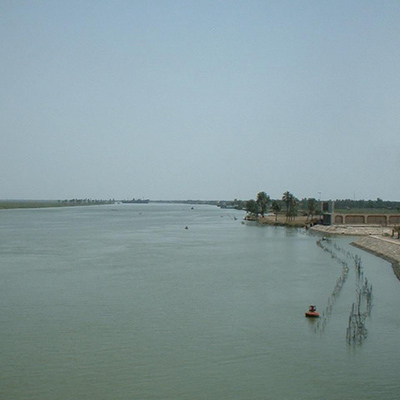Sites
Arvand Rud
Written by: Marzieh Abedini.
Translated by: Hadi Qorbanyar
138 Views
Arvand Rud is a major river in southwestern Iran, which forms part of the border with Iraq. In February 1986, during Operation Valfajr 8, Iranian forces crossed the river and captured the port city of Al-Faw.
In the Achaemenid era, the river was known as Tigr or Tigra, meaning “swift and vigorous”.[1] The river known today as Arvand Rud did not exist in its current form until around 3000 BCE, and the Tigris, Euphrates, and Karun rivers each flowed separately into the Persian Gulf. After the fall of the Sasanian Empire, due to a lack of maintenance, dams broke, and a river about 175 kilometers in length was formed at the confluence of the Euphrates and Tigris rivers in the town of Al-Qurnah.
Today, 81 kilometers of the river constitute the Iran–Iraq border down to its mouth, where it discharges into the Persian Gulf. Arvand Rud varies in width from about 500 to 1000 meters, while its depth fluctuates between 9 and 15 meters depending on tidal conditions, yet it remains navigable throughout. Because of tidal effects and the nature of its currents—calm at the surface but fast and turbulent in its depths—Arvand Rud is also known as the “wild river”.[2]
Each day, the river experiences two tides and two ebbs. During high tide, the water flows towards Basra, and during low tide, in the opposite direction.[3] These occur roughly every six hours. As a result of these tidal movements and whirlpools forming in the depths, the speed of the water would reach 70 kilometers per hour.[4]
Arvand Rud is fed by the Tigris and Euphrates rivers, which originate in Turkey, as well as by the Karun, Karkheh, Great Zab, Little Zab, Diyala, Bakoor, Sirwan, and Alvand rivers, all of which rise in Iran. Approximately 67 percent of the water volume in the Arvand Rud originates from Iranian rivers. The riverbanks are covered with chulan (tall shrubs) and reeds, while its date palm groves extend from 2 to 5 kilometers inland. These groves are irrigated during high tide via a network of canals and man-made streams that run perpendicular to the river.[5]
The Iranian cities and major ports of Abadan —Iran’s largest port for petroleum exports—Khorramshahr, an important hub for international trade, and the Iraqi cities and major ports of Basra and Al-Faw[6] are situated along this river.[7]
The city of Arvandkenar, a district of Abadan, has developed in a linear form along the banks of the Arvand Rud through the merging of 12 villages.[8]
Since its establishment at the end of World War I, Iraq has consistently made illegitimate claims to full ownership of the Arvand Rud, making it one of the principal issues in the Iran–Iraq border disputes. Eventually, under the Algiers Accords of 1975, the thalweg (deepest channel) of the waterway was recognized as the official border.
Following the victory of the Islamic Revolution in Iran in 1979, the Baathist regime repeatedly asserted its claim of ownership over this waterway. In June 1979, it reinforced its border posts along the Arvand by deploying patrol boats and flying helicopters over the river. This became one of the pretexts for the Baathist regime’s full-scale military invasion of the Islamic Republic of Iran on 22 September 1980.
With the outbreak of the imposed war, given the conditions of the Arvand Rud—its considerable width and the tidal influence of the Persian Gulf, which restricted military maneuvers—both Iranian and Iraqi forces relied on artillery bombardments against military and civilian facilities along the opposite banks. In the second month of the war, while bombarding Abadan from the southern shore of the river, the Iraqi army advanced from the north of the city, and on October 31, 1980, after crossing the Bahmanshir (a branch of the Karun River in Khuzestan), reached Arvand Rud. In an effort to secure complete control over the northern banks of the Arvand Rud, enemy forces advanced via the Khosroabad road towards Arvandkenar. The attack, however, was repelled by Iranian troops.[9]
After Iran’s Operation Badr on March 11, 1985, in the southern Hoor al-Hawizeh, and with Iraq recognizing its own incapacity alongside Iran’s growing initiative, the Baathist regime—backed by financial support from Arab states such as Kuwait and Saudi Arabia, as well as Western military and propaganda assistance—undertook large-scale defensive measures. It drained numerous lagoons and canals in the Al-Faw region along the banks of the Arvand Rud to construct roads for its military units. Even the Iraqis installed interception and Razit radar systems in certain areas. Iraq also mined the entire western bank of the Arvand Rud and, in its forward positions, deployed sunburst obstacles integrated with flares and encircled by barbed-wire entanglements. To dominate Iran’s supply routes, the enemy built tall observation towers in the region. In addition to these fortifications, Iraq conducted reconnaissance flights, filming and photographing the area, while also making use of Western satellites and AWACS surveillance aircraft.
After Operation Badr, Iranian military commanders identified Al-Faw as a key objective for their next offensive, due to its strategic importance in disrupting Iraq’s maritime access, its geographic closeness to Kuwait, and its potential to secure dominance over the northern part of the Persian Gulf. Since the beginning of the war, no operation had been launched in this area, and the turbulence of the Arvand Rud had convinced the enemy that Iran would never be able to cross it and penetrate into Iraqi territory. factors such as the marshy terrain—which denied the enemy maneuverability—the quietness of the region, the shallow depth of the Iraqi rear positions, and the target’s exposure to Iranian artillery and mortar fire led commanders, after initial planning, to shift their focus towards launching an operation at the end of Arvand Rud.
Drawing on the experience of operations Badr and Kheibar, bridges were constructed for crossing the river.[10] After months of intensive training, logistical coordination, reconnaissance, area preparation, and force mobilization, Operation Valfajr 8 was launched on February 9, 1986. Iranian forces crossed the Arvand Rud between Khosroabad and Ras al-Bisheh, initiating their advance into the strategically vital Al-Faw Peninsula. Despite Iraq’s heavy fire and the use of chemical weapons, all operational objectives were achieved.[11]
Following the end of the war and Iraq’s renewed recognition of the Algiers Accords, Arvand Rud gradually regained its vitality. However, its navigability for large commercial vessels was effectively reduced due to silt accumulation and the presence of sunken wreckage.[12]
Among those who played a key role in that operation was Hassan Yazdani, a member of the intelligence and reconnaissance unit of the 41st Tharallah (as) Division. Remembered for having crossed the Arvand Rud 30 times, he was martyred during Operation Valfajr 8.[13]
Today, the Valfajr 8 Martyrs’ Memorial is located 30 kilometers from Abadan, across from the Iraqi city of Al-Faw on the northern bank of Arvandkenar. It has become a destination for visitors who come to this place via the Rahian-e Noor caravans. In 2001, on the day of Ashura, 8 unidentified martyrs of the Sacred Defense were buried at the site in a ceremony attended by the people of Arvandkenar, Rahian-e Noor caravans, and units of the 25th Karbala Division of the Islamic Revolutionary Guard Corps as well as the Army.[14] Several books have been written about Arvand Rud, including Arvand by Mojtaba and Muhammad-Reza Nikrahi; Arvand Yademanhai-e Jonoub: Qeteie as Aseman (Arvand, Southern Memorials: A Piece of Heaven) by Mustafa Ahmadi; and Razhai-e Arvand (Secrets of Arvand) by Masoud Farshidnia and Sousan Rahmanian.
[1] Yousefi, Muhammad, Peivastangah-e Karun va Arvand Rud ya Tarikh Khorramshahr (Khorramshahr: Karun and Arvand Rud Junction or the History of Khorramshahr), [Bi Ja], [Bi Na], Ch 2, 1350, p. 27.
[2] Pourjabbari, Pejman, Atlas-e Joghrafi-ye Hamasi 1: Khuzestan dar Jang (Epic Geography Atlas 1: Khuzestan in War), Tehran, Sarir, 1389, p. 78.
[3] Rahnamaye Zaeran-e Rahian-e Noor Mantaqe-ye Amaliati-ye Jonoub (Guide for Pilgrims of Rahian-e Noor Caravans: Southern Operational Areas), Moasseseye Emad, Tehran, Ketab-e Yousef, Ch 2, 1389, p. 108.
[4] Farshidnia, Masoud & Sousan Rahmanian, Razha-ye Arvand: Se Shab-e Jang dar Arvand Rud (Secrets of Arvand: Three Nights of War in Arvand Rud), Jahrom, Boniz, 1392, p. 29.
[5] Pourjabbari, Pejman, Ibid., p. 78.
[6] Hatef, Mahmoud, Ravabet Iran va Araq va Masale-ye Arvand Rud (Iran-Iraq Relations and the Arvand Rud Issue), Tehran, Pajang, 1371, p. 48.
[7] Pourjabbari, Pejman, Ibid., p. 78.
[8] Farhang-e Joghrafi-ye Abadiha-ye Keshvar: Ostan-e Khuzestan, Shahrestanha-ye Abadan, Khorramshahr, Dasht-e Azadegan va Zamaem-e Anha dar Dorane Defa Muqaddas (Geographical Dictionary of Villages in Iran: Khuzestan Province, Abadan, Khorramshahr, Dasht-e Azadegan and their Counties during the Sacred Defense), Sazman-e Joghrafi-ye Niruhaye Mosalah, Tehran, Sazman-e Joghrafi-ye Niruhaye Mosalah, 1385, Pp. 63, 65.
[9] Pourjabbari, Pejman, Ibid., p. 79.
[10] Samiei, Ali, Karname-ye Towsifi-ye Amaliat-e Razmandegan-e Eslam dar Tol-e Hasht Sal-e Defa Muqaddas: Lashkar 16 Qods-e Gilan (Descriptive Record of Muslim Fighters’ Operations during the Eight-Year Sacred Defense: 16th Qods Gilan Division), Tehran, Sepah-e Pasdaran-e Enqelab-e Eslami, 1376, Pp. 209-211.
[11] Rahnamaye Zaeran-e Rahian-e Noor Mantaqe-ye Amaliati-ye Jonoub (Guide for Pilgrims of Rahian-e Noor Caravans: Southern Operational Areas), p. 110.
[12] Pourjabbari, Pejman, Ibid., p. 79.
[13] Khabargozari-ye ISNA (ISNA News Agency), 1392, Code 92021711495.
[14] Rahnamaye Zaeran-e Rahian-e Noor Mantaqe-ye Amaliati-ye Jonoub (Guide for Pilgrims of Rahian-e Noor Caravans: Southern Operational Areas), p. 112.





